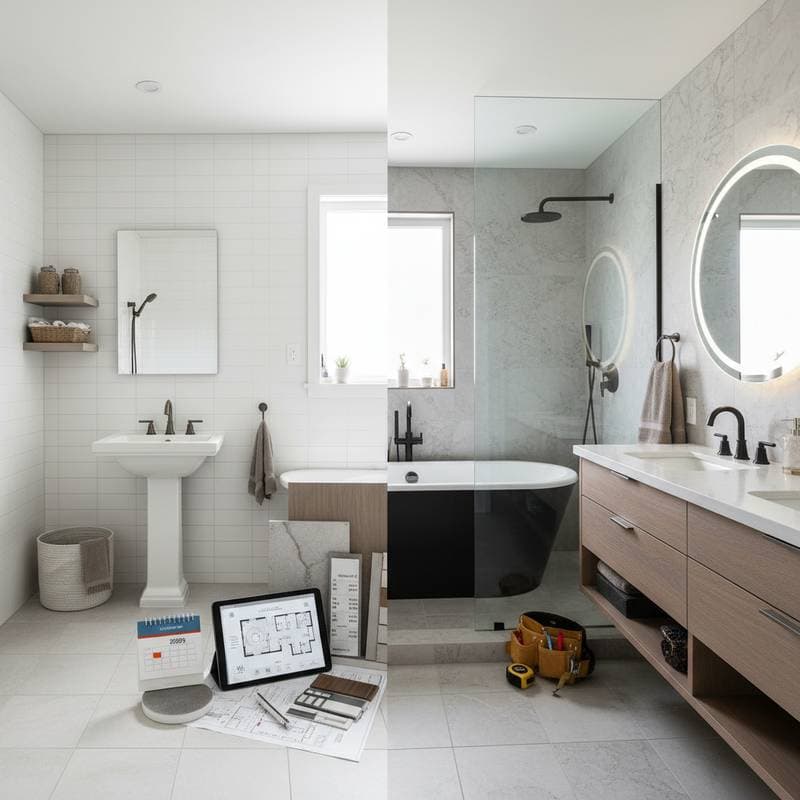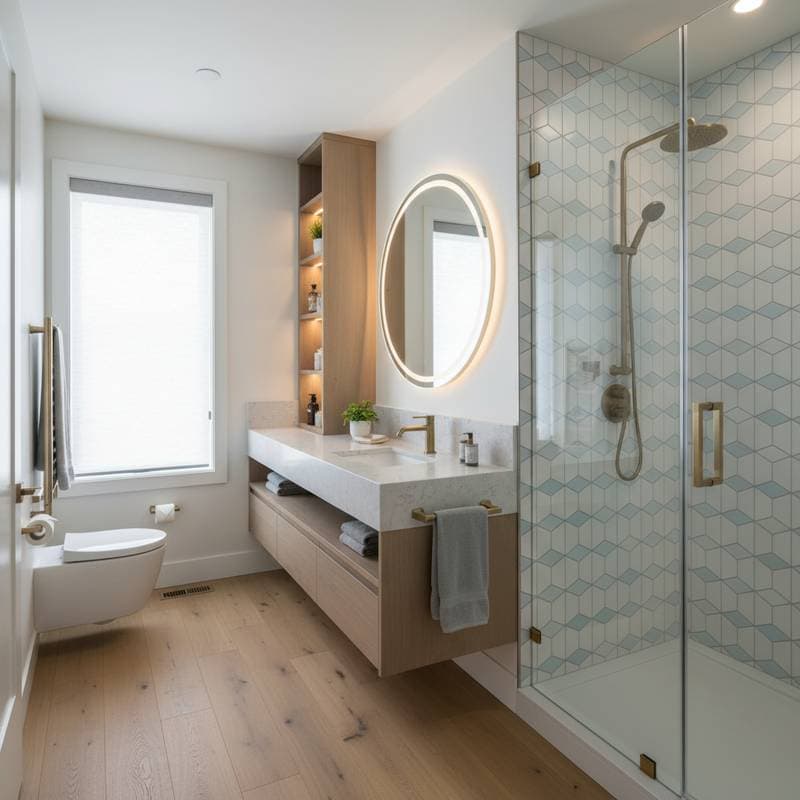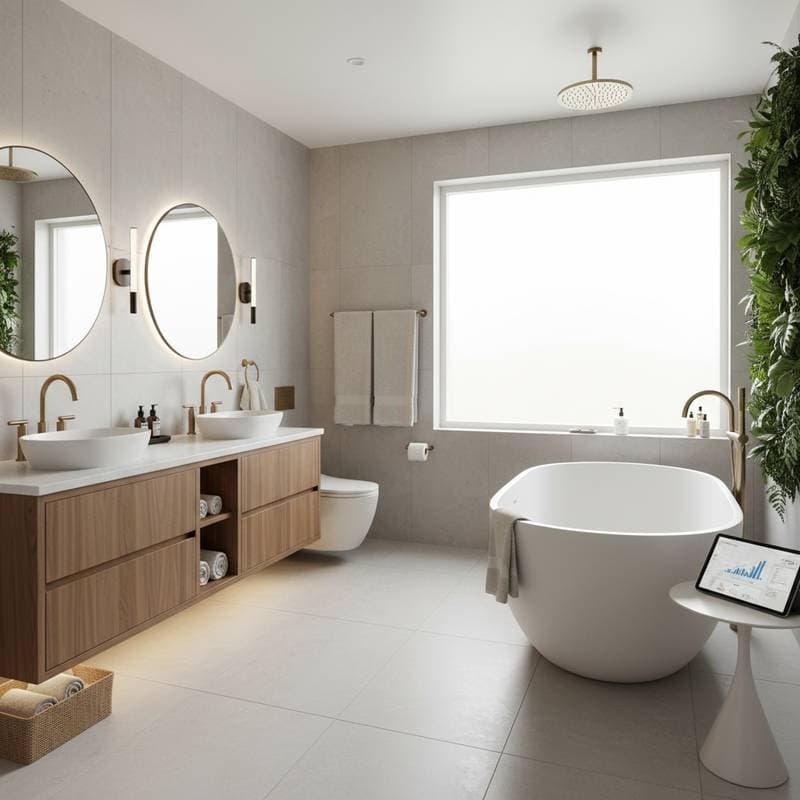What 2025 Bathroom Remodels Really Cost Homeowners
A bathroom remodel appears straightforward initially, yet it frequently evolves into a complex array of choices and expenditures. Homeowners undertake these projects to update fixtures, enhance accessibility, or design a serene retreat. Grasping the actual costs involved enables better preparation and avoids financial shocks. Each decision influences the budget in predictable ways once the key factors become clear.
This guide examines the genuine expenses of bathroom remodels, covering materials, labor, upgrades, and unforeseen charges. Readers gain insights into expectations, potential risks, and informed budgeting strategies that yield substantial benefits.
The Quick Answer: What Homeowners Are Spending
Full bathroom remodels typically range from 9,000 to 28,000 dollars, influenced by room dimensions, material selections, and the extent of professional versus self-performed work. A modest half-bath refresh may total 3,500 to 7,500 dollars, whereas an upscale primary bathroom overhaul could surpass 45,000 dollars.
The following table provides a cost overview by bathroom category:
| Bathroom Type | Typical Size (sq. ft.) | Average Cost Range | Cost per Sq. Ft. |
|---|---|---|---|
| Half Bath | 20 to 30 | 3,500 to 7,500 | 150 to 250 |
| Full Bath | 40 to 60 | 9,000 to 18,000 | 180 to 300 |
| Primary Bath | 80 to 120 | 18,000 to 45,000 | 200 to 400 |
| Luxury Spa Bath | 100 to 150 | 30,000 to 60,000+ | 300 to 500 |
These estimates incorporate mid-level materials and expert installation. Opting for personal involvement in certain tasks or economical fixtures can reduce expenses by up to 30 percent.
Why Bathroom Remodel Costs Vary So Widely
Bathroom remodels encompass three primary expense areas: materials, labor, and mechanical systems. The allocation among these elements shapes the overall investment.
Materials and Finishes
Materials represent 45 to 55 percent of the total budget. Prices for tile, vanities, and fixtures fluctuate significantly. Porcelain tile ranges from 2 to 10 dollars per square foot, in contrast to natural stone at 8 to 25 dollars per square foot. A prefabricated vanity begins at approximately 500 dollars, while custom options often exceed 2,000 dollars. Standard faucets fall between 75 and 200 dollars, with designer versions surpassing 600 dollars.
Selecting robust, mid-range items delivers optimal long-term value. Steer clear of inexpensive fixtures prone to early failure and subsequent replacement.
Labor and Installation
Labor constitutes 40 to 50 percent of the project total. Qualified plumbers and electricians bill 75 to 150 dollars hourly, and tile specialists charge 8 to 25 dollars per square foot based on design intricacy.
Preserving the existing layout minimizes labor demands. Relocating plumbing or drainage adds 1,000 to 3,000 dollars rapidly.
Hidden Mechanical Costs
Concealed structural elements frequently catch homeowners off guard. Key examples include:
- Waterproofing materials: 300 to 800 dollars
- New electrical circuits: 400 to 1,000 dollars
- Ventilation improvements: 250 to 600 dollars
- Subfloor fixes due to leaks: 500 to 2,000 dollars
Allocate 10 to 15 percent of the budget for such unforeseen needs.
Breaking Down Costs by Project Element
Each remodel component carries a distinct price spectrum. Understanding these allows for targeted spending priorities.
| Component | Budget Range | Notes |
|---|---|---|
| Vanity & Countertop | 500 to 3,000 | Includes sink and faucet |
| Flooring | 800 to 2,500 | Tile, vinyl, or engineered wood |
| Shower or Tub | 1,000 to 6,000 | Prefab units cost less than tiled surrounds |
| Toilet | 250 to 800 | Comfort height models enhance accessibility |
| Lighting | 150 to 1,200 | Vanity lights, recessed fixtures, or sconces |
| Plumbing Updates | 1,000 to 3,500 | Replacing valves, drains, or supply lines |
| Painting & Trim | 300 to 1,000 | Moisture-resistant paint recommended |
A well-distributed remodel assigns roughly 30 percent to fixtures, 30 percent to tile and flooring, 30 percent to labor, and 10 percent to finishes and decor.
DIY vs. Hiring a Professional
Strategic self-work can reduce costs by thousands, though certain elements demand professional expertise to meet safety and code standards.
What You Can Tackle Yourself
- Painting walls and trim
- Installing mirrors and accessories
- Replacing faucets or showerheads
- Laying vinyl plank flooring
When to Hire a Pro
- Electrical and plumbing tasks requiring permits
- Tile waterproofing and shower pan installation
- Structural framing or subfloor repair
- Ventilation ducting and lighting wiring
Professionals guarantee adherence to regulations and enduring performance, particularly in waterproofing and drainage systems.
Accessibility and Aging-in-Place Upgrades
For long-term residency, incorporating accessibility now proves more efficient than future alterations. These enhancements benefit all users and elevate property appeal.
| Upgrade | Cost Range | Benefit |
|---|---|---|
| Curbless Shower | 2,000 to 5,000 | Easier entry and contemporary aesthetic |
| Grab Bars | 150 to 400 | Enhanced safety and support |
| Comfort Height Toilet | 300 to 800 | Reduced strain on joints |
| Wider Doorway (32 inches) | 500 to 1,200 | Wheelchair-friendly access |
| Handheld Showerhead | 100 to 300 | Versatile application for varied needs |
The National Kitchen & Bath Association advises maintaining at least 30 inches of clear floor space before fixtures for ease of use. For wheelchair maneuverability, provide a 60-inch turning radius.
Regional Price Differences
Labor rates differ by location. Metropolitan zones command higher fees from elevated wages and permitting costs, whereas rural settings feature lower hourly charges but limited specialist availability. Obtain a minimum of three bids from certified contractors, verifying inclusion of labor and materials.
Cost-Saving Tips That Still Deliver Quality
Extend resources effectively while upholding standards. Consider these approaches:
- Maintain the plumbing configuration to sidestep extensive labor charges.
- Refinish existing surfaces; tub reglazing costs 400 to 700 dollars versus full replacement.
- Select large-format tile to minimize grout lines and installation time.
- Choose ready-to-assemble vanities for solid construction at reduced prices.
- Opt for a single expansive mirror over multiple framed units to achieve a sleek appearance affordably.
- Source materials from outlets offering deals on overstock or showroom samples.
Common Mistakes That Increase Costs
Budget overruns stem from avoidable oversights, even among seasoned individuals. Key errors include:
- Neglecting ventilation, which fosters moisture issues leading to mold remediation and surface repairs.
- Selecting unsuitable materials; standard paints or untreated wood deteriorate in damp environments.
- Underestimating demolition efforts, as extracting tile, drywall, and fixtures demands more time and expense than anticipated.
- Bypassing permits, which may necessitate costly fixes during home sales.
- Excessive customization, such as intricate niches or patterns, that prolong labor.
Develop a precise project outline prior to any teardown.
Budgeting for the Unexpected
Thorough preparation cannot eliminate all surprises. Issues like concealed water damage, obsolete pipes, or faulty wiring may arise. Reserve 10 to 20 percent of the budget for contingencies.
Older properties warrant larger reserves. Faulty cast iron drains or degraded copper lines can escalate repairs into thousands of dollars.
Return on Investment
Bathroom updates yield reliable financial recovery. Mid-range efforts recover 55 to 65 percent of costs upon sale, with premium versions attracting premium offers despite marginally lower percentages. Efficient appliances, contemporary illumination, and versatile tile palettes draw prospective buyers and convey modernity.
Prioritize enduring styles for marketability: neutral tones in tile, satin metal accents, and resilient quartz surfaces.
Tools and Materials You'll Need for DIY Work
For minor or segmented tasks, assemble essential equipment upfront. Standard items comprise:
- Tape measure and level
- Wet saw or tile cutter
- Caulk gun and silicone sealant
- Cordless drill and bit set
- Adjustable wrench and plumber's tape
- Grout float and sponge
- Safety glasses and gloves
Lease heavy-duty items, such as tile saws or demolition hammers, from nearby suppliers to bypass ownership costs for infrequent applications.
How to Choose the Right Contractor
The selection of a specialist equals material choices in importance. Seek:
- Valid licenses and insurance covering plumbing, electrical, and general work
- Examples of comparable completions with client endorsements
- Comprehensive written proposals detailing materials, labor, and timelines
- Transparent dialogue on modifications and guarantees
Inquire about phase durations and responsibility for approvals and checks. Reliable partners maintain schedules and fiscal limits.
Energy Efficiency and Sustainability
Incorporate eco-friendly elements to lower ongoing expenses and environmental impact. Low-flow toilets and showerheads reduce water use by up to 50 percent, qualifying for rebates in many areas. LED lighting cuts energy consumption by 75 percent compared to incandescents, while providing brighter, longer-lasting illumination.
Sustainable materials like recycled glass tile or bamboo vanities offer durability without resource strain. Insulate pipes to prevent heat loss, and install humidity-sensing fans that activate only when needed, saving on utility bills and extending fixture life.
Steps to Launch Your Remodel
Begin with a vision aligned to needs and budget. Sketch layouts, gather inspiration from design resources, and compile a prioritized list of features. Consult professionals early for feasibility assessments, secure financing, and schedule inspections to ensure smooth execution. Track progress against the plan to realize a functional, appealing space that enhances daily life and property worth.





